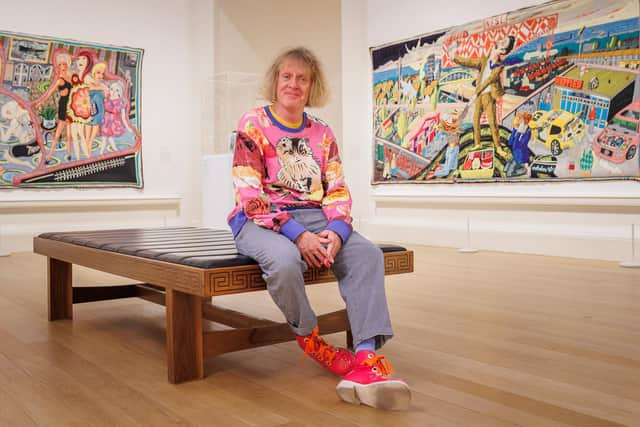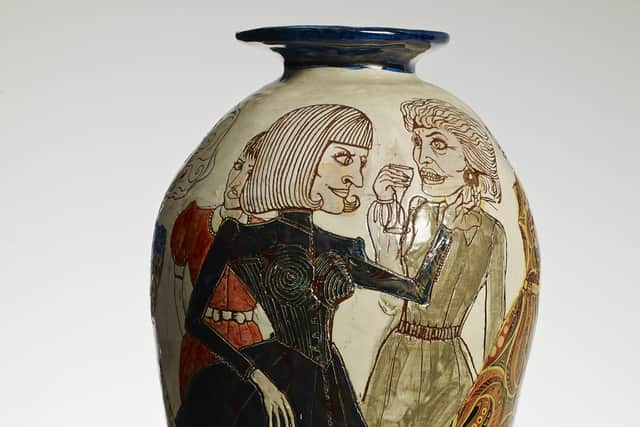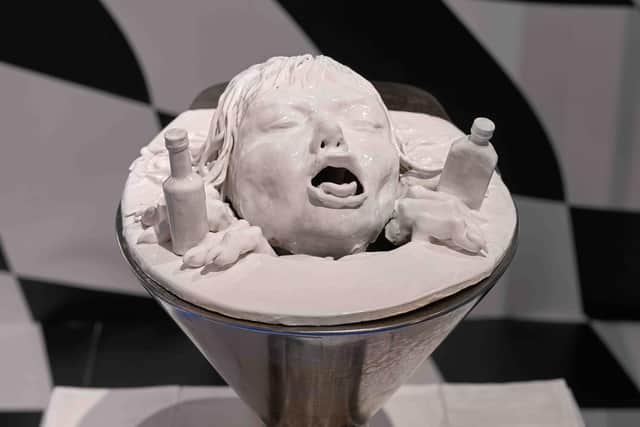Edinburgh Art Festival reviews: Grayson Perry | Lindsey Mendick
Grayson Perry: Smash Hits, National Galleries of Scotland (Royal Scottish Academy), Edinburgh *****
Lindsey Mendick: SH*TFACED, Jupiter Artland, Edinburgh *****
Advertisement
Hide AdGrayson Perry has written an intriguing essay for the catalogue of his exhibition, Smash Hits, and in it he remarks “Despite wariness of making art about important causes, I often like to start with a strong subject, an issue, something I do care about... but I know that the subject is just a framework on which to hang the real business of art, the form, the style, the tone, the texture…” In the show, though, if not the causes themselves, it is the narratives they generate that are first of all striking. Visually tapestries dominate and they are full of detail, narrative and otherwise. The biggest of them, too, the Walthamstow Tapestry is enormous, 15 metres long, but for all the mass of detail it is brilliantly coherent formally. Its title is a homage to William Morris, born in Walthamstow, but it also pays respect to the Bayeux Tapestry and Giotto’s frescoes. Its subject is the Seven Ages of Man, “the journey from birth to death through the lens of shopping,” says the artist. A river of blood flowing from end to end, womb to coffin, connects birth and death. The shopping and much else beside is in the detail. The invention is astonishing.


All the tapestries are produced directly by machine from the artist’s drawing on a computer screen. They include appropriately Selfie with Political Causes, the artist in his signature frock riding on an enormous motorcycle. His childhood teddy bear, Alan Measles, his companion when an unwelcome step-father entered his life and a kind of mascot ever since, appears in several places here including an ironic tapestry, Allan Measles for God.
As well as such individual tapestries, there are also two narrative sets, Julie Cope’s Grand Tour and the six-piece The Vanity of Small Differences. A homage to Hogarth’s Rake’s Progress, the latter tells the story of the rise of Tim Rakewell from working class origins first to success and then to tragedy. It is a scathing analysis of the small differences that make up the layers of the modern class system which, the artist suggests, has been grafted onto, but has not replaced the old one.
If tapestries seem to dominate, the pots are stars nonetheless. Perry began as a potter, choosing pots, he says, because they were low down in the art hierarchy. If so, he has changed that and here in them "the real business of art” is superbly manifest. His pots are beautiful, but he is not at all a fancy potter. Never using a wheel, he only makes coil pots. It is a primitive form, yet he achieves the most elegant results. His glazes too are frequently very beautiful, but here too he finds his own way. He reflects on “issues” in his pots too, of course. Luxury Brands for Social Justice, for instance, reflects satirically on the virtue signalling of market leaders. He also reflects on sex and gender. Precious Boys is decorated with a gathering of transvestites and Sex, Drugs and Earthenware is his potter’s self-portrait. Cocktail Party is a wonderful caricature and Childhood Trauma Manifesting itself in Later Life seems to be a portrait of the artist in an exquisite renaissance dress: an unpromising beginning can have an unexpectedly happy result.
There are also prints and astonishing, complex sculptures, mostly in cast-iron. The most remarkable is the Tomb of an Unknown Craftsman. An elaborate, cast-iron galleon made for Perry’s show in the British Museum, it commemorates all the unknown men and women, from the makers of the first stone axes to the present day, whose anonymous works fill the museum’s collections.


English identity is also a theme, or an issue throughout. Comfort Blanket, for instance, a tapestry banknote eight metres wide and complete with the Queen’s head, is adorned with all the things that make the English, English. It is an interesting choice of topic in a major Scottish show and he seems himself to reflect on this irony in a wonderful slipware plate, Two Old Guys in Checked Skirts. The artist and Alan Measles in kilts, it is also adorned with thistles and saltires. The Cross of St George appears in the show, too, however, at first sight simply as itself, but look closer and the white ground is laid out with a slave ship’s terrible human cargo. No identity is simple.
Advertisement
Hide AdAltogether I haven’t seen the halls of the RSA so well filled by a single living artist since the major Paolozzi retrospective nearly 40 years ago and the two artists do have this in common: both turned the disadvantage of feeling an outsider into an abundant gift of truly original vision.
By coincidence, Lindsey Mendick, showing at Jupiter Artland, is also a ceramicist and hers too is an art of issues, although perhaps more a confession of a personal issue. The show is called SH*TFACED and is an account of the artist’s binge drinking. That maybe sounds like solipsism, the enemy of good art, but that is not at all the case. The show is expansive and reflective, an astonishing display of glazed ceramic sculpture all framed in Stevenson’s classic dichotomy of Jekyll and Hyde: Dr Jekyll sober and Mr Hyde drunk.
Advertisement
Hide AdTwo parts of the show are in the steading where the walls and floor are painted in a pattern of black and white tiles, but the squares quickly deform into swaying, drunken curves. A comical, table-top panorama of a pub/club scene with tiny ceramic figures is arranged like Dante’s vision of Hell, with fiery gates and circular levels descending like the bowgescorrect of the Inferno to a monstrous Satan at the centre; not the Divine Comedy perhaps, but a dark human comedy. Like Hieronymus Bosch, too, some of the figures have turned into half-human monsters. She herself is recognisable by her green hair.


Further down the room and on a different scale, is an assembly of mostly white-glazed ceramic sculpture. Without being precisely scatological, the installation is certainly lavatorial; the centrepiece is a nightmare vision of the mirror and basin in a ladies’ loo. Site of confrontations with your drunken self, perhaps, the mirror is decorated with snakes, poisonous frogs and plants. The piece is also two-sided. On one side the basin seethes with octopus and jellyfish, on the other with evil-looking snakes. Nearby in an anguished self-image, echoing Caravaggio’s self-portrait as the head of Medusa, the artist’s own face and fingers emerge through a lavatory seat. There is much else and some of it is pretty startling, but the delicacy of execution overcomes the unpromising subject matter touching it with wit and irony; as with Jekyll and Hyde, both sides of the dichotomy are human.
The beauty of execution is even more remarkable in the part of the show set in the ballroom. A row of vases, all in white ceramic and in the form of elaborately costumed, life-size sculptured busts, are arranged along a table like a dinner party of Victorian ghosts. There are bottles, glasses and cigars. As vases, the figures are hollow and also headless – in Scots, out of their heids, perhaps – drunk. The glazed white ceramic is delicate and visibly fragile, as fragile perhaps as the boundary that separates Dr Jekyll from Mr Hyde. The detail of the costume chimes with the elegant, rococo-style plaster ceiling and suggests Victorian respectability, but the headless, upholstered bosoms and straining waistcoats suggest something quite other. The whole ensemble is surreal, ironical and darkly comic: black comedy in white china.
Grayson Perry until 12 November; Lindsey Mendick until 1 October